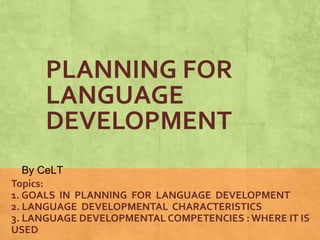
Planning for language development
- 1. PLANNING FOR LANGUAGE DEVELOPMENT By CeLT Topics: 1. GOALS IN PLANNING FOR LANGUAGE DEVELOPMENT 2. LANGUAGE DEVELOPMENTAL CHARACTERISTICS 3. LANGUAGE DEVELOPMENTAL COMPETENCIES : WHERE IT IS USED
- 2. LANGUAGE DEVELOPMENT Machado (1985,p. 2) defines language development as : “a system of intentional communication through SOUNDS SIGNS (gestures) or SYMBOLS which are understandable to others.” xc
- 3. Language is a two-way street that involves both: listening to others and communicating information to them It serves as the foundation for most other types of learning.
- 4. For communication to take place: Speakers and listeners must use the SAME CODE SYSTEM 1.PHONOLOGY – sound system within a language 2.MORPHOLOGY – word structure 3.SYNTAX – how words are put together in meaningful order to form sentences / grammar 4.SEMANTICS – study of meaning; most important code signal
- 5. Importance of Language Skills According to the American Speech, Language and Hearing Association, language is not the same as speech. Language : • consists of a set of rules, shared by the individuals who are communicating, that allows them to exchange those thoughts, ideas or emotions in order to express and receive information in a meaningful way. •can include spoken word but may also be expressed through writing, signing or gestures.
- 6. Speech is the verbal expression of language and consists of voice articulation
- 7. Important things to remember: The most intensive period of speech and language development occurs during the first three years of life. Language seems to develop best in an environment that is loving, caring and interactive.
- 8. LANGUAGE DEVELOPMENTAL CHARACTERISTICS/ MILESTONES: AGE MILESTONES 0–5 months • Cries, coos, laughs, and vocalizes sounds, expressing both pleasure and displeasure. Often an adult can tell the meaning of these sounds, for example: “I’m hungry.” • The baby watches the caregiver’s face when he or she speaks and will make sounds in response •Gradually eliminate the sounds that are not used around them 6–11 months • Baby desires to communicate and has a full range of gestures • Babbling begins • May repeat the sounds caregiver makes
- 9. LANGUAGE DEVELOPMENTAL CHARACTERISTICS/ MILESTONES: AGE MILESTONES 12-17 months • Seeks attention or tries to direct attention to something in the environment • Can follow simple directions with gestures • First words develop • Some children will attempt combining 2 or more words 18-23 months • Children demand desired objects or request an action by pointing, gesturing, or using words • Some words may not be clear • Child understands simple requests without gestures and verbs like “eat” and “sleep”
- 10. LANGUAGE DEVELOPMENTAL CHARACTERISTICS/ MILESTONES: AGE MILESTONES 2-3 years •Child has a vocabulary of about 900 words •At age 2, child is beginning to understand and use words for spatial concepts (in, on) pronouns (mine, you) descriptive words (big, happy) numerical concepts (many, few) simple and compound sentences • Uses plural suffix /s/ 3-4 years • Child has a vocabulary of about 1500 words • Speech becomes more complex with more adjectives, adverbs, pronouns and prepositions • Past tense verb appears but may over generalize the ed and s markers
- 11. LANGUAGE DEVELOPMENTAL CHARACTERISTICS/ MILESTONES: AGE MILESTONES 4-5 years •Vocabulary approximately: 2,500 words • Language is more abstract • Master most basic rules of language • Produces grammatically correct sentences 5-6 years • Understand approximately 6,000 words • Use complex sentences quite frequently • Use correct pronouns and verbs in the present and past tense • Average sentence length is 6.8 words
- 12. LANGUAGE DEVELOPMENTAL CHARACTERISTICS/ MILESTONES: AGE MILESTONES 6-7 years • Average sentence length is 7.5 words • Speak in complex sentences that use adjectival clauses • Conditional clauses beginning with if begin to appear • Begins to read and write •Understands concepts of time and season
- 13. Goals for Planning Language Development FOR CHILDREN TO: Communicate well Develop receptive language Develop expressive language Participate in conversations Understand and use words Enjoy books and being read to Show an awareness of pictures and print Experiments with drawing and writing the ability to understand or comprehend language heard or read being able to put thoughts into words and sentences, in a way that makes sense and is grammatically accurate
